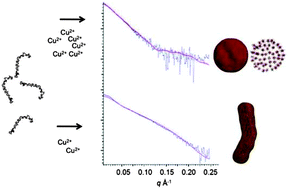Small angle X-ray scattering analysis of Cu2+-induced oligomers of the Alzheimer's amyloid β peptide
Abstract
Research into causes of Alzheimer's disease and its treatment has produced a tantalising array of hypotheses about the role of transition metal dyshomeostasis, many of them on the interaction of these metals with the neurotoxic amyloid-β peptide (Aβ). Here, we have used small angle X-ray scattering (SAXS) to study the effect of the molar ratio, Cu2+/Aβ, on the early three-dimensional structures of the Aβ1–40 and Cu2+/Aβ1–42 peptides in solution. We found that at molar ratios of 0.5 copper to peptide Aβ1–40 aggregated, while Aβ1–42 adopted a relatively monodisperse cylindrical shape, and at a ratio of 1.5 copper to peptide Aβ1–40 adopted a monodisperse cylindrical shape, while Aβ1–42 adopted the shape of an ellipsoid of rotation. We also found, via in-line rapid mixing SAXS analysis, that both peptides in the absence of copper were monodisperse at very short timeframes (<2 s). Kratky plots of these scattering profiles indicated that immediately after mixing both were intrinsically disordered. Ensemble optimisation modelling reflected this, indicating a wide range of structural conformers. These data reflect the ensembles from which the Cu2+-promoted oligomers were derived. Our results are discussed in the light of other studies that have shown that the Cu2+/Aβ has a marked effect on fibril and oligomer formation by this peptide, with a higher ratio favouring the formation of cytotoxic non-amyloid oligomers. Our results are relatively consistent with previous two-dimensional studies of the conformations of these Cu2+-induced entities, made on a much longer time-scale than SAXS, by transmission electron microscopy and atomic force microscopy, which showed that a range of oligomeric species are formed. We propose that SAXS carried out on a modern synchrotron beamline enables studies on initial events in disordered protein folding on physiologically-relevant time-scales, and will likely provide great insight into the initiating processes of the Aβ misfolding, oligomerisation and amyloid formation.

- This article is part of the themed collection: Alzheimer's Research Month 2016

 Please wait while we load your content...
Please wait while we load your content...